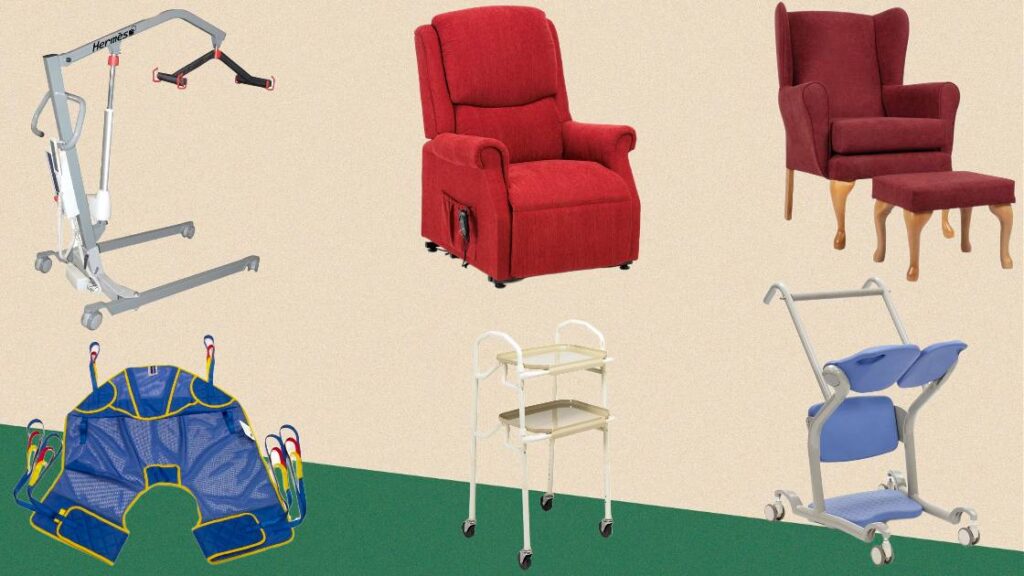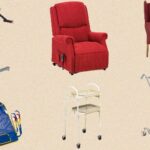Daily Living Aids for Elderly and Disabled Individuals

Introduction:
As we age, performing daily activities can become a challenging task, especially for individuals with disabilities. That's where daily living aids come in handy. Daily living aids can help disabled and elderly individuals to lead independent life by providing them with the necessary support to perform daily activities.
In this ultimate guide to daily living aids for elderly and disabled individuals, we'll cover everything you need to know about living aids, their types, and their benefits. We'll also provide you with a list of essential living aids and how they can assist in different aspects of daily living.
Dressing Aids:
Dressing can be a challenging task for individuals with disabilities. However, with the help of dressing aids, it can become an easy and manageable task. Dressing aids such as button hooks, zipper pulls, and elastic shoelaces can help individuals with limited mobility to dress themselves. Other dressing aids include dressing sticks, sock aids, and long-handled shoe horns that can assist individuals in putting on shoes, socks, and other clothing. Click here to view our dressing aids catalogue
Bed and Chair Aids:
Bed and chair aids are essential for individuals who have difficulty getting up or sitting down. Bed rails and bed sticks can provide support to individuals while getting in and out of bed. Chair raisers, on the other hand, can elevate chairs to a more comfortable height for individuals with limited mobility. Additionally, seat cushions, backrests, and pressure relief cushions can provide comfort and support to individuals who spend extended periods in bed or sitting in chairs. Click here to view our bed and chair aids catalogue
Household Aids:
Household aids are designed to help individuals perform daily activities such as cooking, cleaning, and gardening. Kitchen aids such as adapted knives, chopping boards, and jar openers can help individuals with limited hand strength to prepare meals independently. Cleaning aids such as long-handled dustpans and brushes, and reacher grabbers can assist individuals with mobility issues in cleaning their homes. Gardening aids such as long-handled pruners and trowels can help individuals with limited mobility to pursue their gardening hobbies. Click here to view our household aids catalogue
Trays and Trolleys:
Trays and trolleys can provide a convenient way to transport items around the house. These aids can be especially useful for individuals with mobility issues who find it difficult to carry things around. Wheeled trolleys and walking frames with trays can help individuals transport meals, drinks, and other items from one room to another. Lap trays can provide a convenient surface for eating meals or working on a laptop. Click here to view our trays and trolleys catalogue
Riser Recliner Chairs:
Riser recliner chairs are an excellent aid for individuals with limited mobility who spend extended periods sitting. These chairs can help individuals get in and out of a seated position and also provide support and comfort while sitting. Riser recliner chairs come in a variety of designs, including single-motor, dual-motor, and wall-hugger models. Click here to view our riser recliner chairs catalogue
High Back Chairs:
High-back chairs are designed to provide additional support to individuals who have difficulty maintaining a good sitting posture. These chairs have high backs, which can help individuals with back pain or other conditions to sit comfortably for extended periods. High-back chairs come in a range of styles and materials, including leather, fabric, and vinyl. Click here to view our high back chairs catalogue
Mobile Hoists:
Mobile hoists can be an essential aid for individuals who require assistance with transferring from one position to another. These hoists can assist individuals in getting in and out of bed, on and off chairs, and in and out of the bathroom. Mobile hoists come in a range of sizes and weight capacities, making them suitable for different individuals and settings. Click here to view our mobile hoists catalogue
Slings:
Slings are used in conjunction with mobile hoists to provide additional support and comfort to individuals during transfers. Slings come in a range of designs and materials, including padded and unpadded slings, and full-body slings. Click here to view our slings catalogue
Transfer Aids:
Transfer aids can help individuals with mobility issues to move from one position to another safely and comfortably. These aids include transfer boards, transfer discs, and transfer belts. Transfer boards are used to transfer individuals from one surface to another, such as from a bed to a wheelchair. Transfer discs are designed to assist individuals in pivoting and transferring from a seated to a standing position. Transfer belts can be used to assist individuals in standing up or sitting down. Click here to view our transfer aids catalogue
Conclusion:
Daily living aids can help individuals with disabilities or elderly individuals to lead independent and fulfilling life. In this ultimate guide to daily living aids, we've covered essential aids that can assist in different aspects of daily living, including dressing aids, bed and chair aids, household aids, trays and trolleys, riser recliner chairs, high-back chairs, mobile hoists, slings, and transfer aids.
It's important to remember that everyone's needs and requirements are unique, and daily living aids should be chosen based on individual circumstances. When selecting a living aid, it's essential to consider factors such as mobility, strength, and comfort to ensure that the aid is suitable and effective for the individual.
By using the right daily living aids, individuals with disabilities and elderly individuals can maintain their independence and enjoy a better quality of life. Whether it's performing daily activities, pursuing hobbies, or spending time with loved ones, daily living aids can help individuals to live their lives to the fullest.
Daily Living Aids for the Elderly:
As we age, simple tasks can become more challenging. Daily living aids for the elderly include products like reachers, dressing aids, and mobility aids that can help seniors maintain their independence and improve their quality of life.
Daily Living Aids for the Disabled:
Daily living aids for the disabled are designed to help individuals with physical, cognitive, or sensory impairments perform daily activities. These aids can include everything from adaptive utensils and communication devices to mobility aids and home modifications.
Daily Living Aids for Arthritis:
Arthritis can make simple tasks like getting dressed or opening jars difficult. Daily living aids for arthritis can help ease pain and make these tasks more manageable. Products like jar openers, sock aids, and specialized kitchen tools can make a big difference.
Daily Living Aids for the Handicapped:
Daily living aids for the handicapped are similar to those for the disabled, but may be specifically designed for individuals with a physical or cognitive disability from birth or early childhood. These aids can include things like adapted toys, communication devices, and mobility aids.
Daily Living Aids for the Blind:
Daily living aids for the blind are designed to help individuals with visual impairments perform daily tasks. These aids can include braille watches, talking watches, tactile markers, and specialized kitchen tools.
Daily Living Aids for ALS Patients:
ALS, or Lou Gehrig's disease, is a progressive neurodegenerative disease that can cause physical disabilities. Daily living aids for ALS patients can include mobility aids, communication devices, and specialized equipment to help with daily tasks.
Daily Living Aids for Arthritic Hands:
Arthritis can make it difficult to grip and manipulate objects with the hands. Daily living aids for arthritic hands can include special grips for utensils, pens, and other objects, as well as specialized tools for gardening and other activities.
Daily Living Aids for the Visually Impaired:
Daily living aids for the visually impaired can include magnifiers, talking watches, and other tools to help individuals with low vision perform daily tasks. These aids can make a big difference in maintaining independence and quality of life.
Daily Living Aids for Stroke:
After a stroke, daily tasks can become more challenging. Daily living aids for stroke can include mobility aids, communication devices, and specialized equipment to help with activities like dressing and eating. These aids can help stroke survivors maintain their independence and regain their quality of life.
What are daily living aids?
Daily living aids are devices, tools, or equipment that help people with disabilities or mobility issues to perform everyday tasks and activities independently. These aids can range from simple tools such as reachers and grabbers to more complex equipment like motorized wheelchairs and lift chairs.
Who can benefit from using daily living aids?
Daily living aids can benefit people of all ages who have physical or cognitive disabilities, limited mobility, or chronic health conditions that affect their ability to perform daily tasks. They can also be useful for people who are recovering from an injury or surgery.
What types of daily living aids are available?
There are many types of daily living aids available, including:
1. Bathing and showering aids such as shower chairs, bath benches, and transfer benches.
2. Dressing aids such as sock aids, button hooks, and zipper pulls.
3. Eating and drinking aids such as adaptive utensils, cups, and plates.
4. Mobility aids such as canes, walkers, rollators, and wheelchairs.
5. Home safety aids such as grab bars, bed rails, and door knob adapters.
Where can I find daily living aids?
Daily living aids can be found at medical supply stores, online retailers like us, and some pharmacies. They can also be prescribed or recommended by healthcare professionals such as occupational therapists or physical therapists.
Are daily living aids covered by insurance?
In some cases, daily living aids may be covered by insurance if they are deemed medically necessary by a healthcare professional. However, coverage and reimbursement can vary depending on the type of insurance and the specific aid needed.
How do I know which daily living aid is right for me?
Choosing the right daily living aid depends on your specific needs and abilities. It is recommended to consult with a healthcare professional such as an occupational therapist or physical therapist who can assess your needs and recommend appropriate aids. You can also consult with a medical supply store or online retailer like us, we can provide guidance and product recommendations.
Can I use daily living aids without assistance?
Many daily living aids are designed to be used independently, but some may require assistance or training to use correctly and safely. It is important to read and follow instructions carefully and seek assistance if needed
How do I maintain and clean my daily living aids?
Maintaining and cleaning your daily living aids can help ensure their effectiveness and longevity. Care and cleaning instructions can vary depending on the type of aid and material used, but generally, it is recommended to clean aids regularly with soap and water or a disinfectant solution and store them in a clean, dry area.
What are dressing aids?
Dressing aids are devices that help individuals with disabilities or mobility issues to dress independently. These aids include tools such as dressing sticks, button hooks, zipper pulls, and sock aids.
Who can benefit from using dressing aids?
Dressing aids can be beneficial for individuals with disabilities or mobility issues, including those with arthritis, back pain, or limited hand and arm mobility.
What are bed and chair aids?
Bed and chair aids are devices that help individuals with disabilities or mobility issues to get in and out of bed or chairs safely and comfortably. These aids include bed rails, bed transfer handles, and chair risers.
Who can benefit from using bed and chair aids?
Bed and chair aids can be beneficial for individuals with disabilities or mobility issues, including those with back pain, hip pain, or limited mobility.
What are household aids?
Household aids are devices that help individuals with disabilities or mobility issues to perform everyday tasks around the house. These aids include tools such as long-handled reachers, jar openers, and door knob turners.
Who can benefit from using household aids?
Household aids can be beneficial for individuals with disabilities or mobility issues, including those with arthritis, back pain, or limited hand and arm mobility.
What are trays and trolleys?
Trays and trolleys are devices that help individuals with disabilities or mobility issues to carry items around the house. These aids include items such as wheeled trolleys, serving trays, and lap trays.
Who can benefit from using trays and trolleys?
Trays and trolleys can be beneficial for individuals with disabilities or mobility issues, including those with limited mobility or strength.
What are riser recliner chairs?
Riser recliner chairs are chairs that can be adjusted to help individuals with disabilities or mobility issues to get in and out of a seated position safely and comfortably.
Who can benefit from using riser recliner chairs?
Riser recliner chairs can be beneficial for individuals with disabilities or mobility issues, including those with back pain, hip pain, or limited mobility.
What are high-back chairs?
High-back chairs are chairs that provide additional support to individuals with disabilities or mobility issues. These chairs typically have higher backs and armrests to provide extra support.
Who can benefit from using high-back chairs?
High-back chairs can be beneficial for individuals with disabilities or mobility issues, including those with back pain, hip pain, or limited mobility.
What are mobile hoists?
Mobile hoists are devices that help individuals with disabilities or mobility issues to move from one position to another safely and comfortably. These hoists include items such as patient lifts and standing hoists.
Who can benefit from using mobile hoists?
Mobile hoists can be beneficial for individuals with disabilities or mobility issues who require assistance with standing or transferring from one surface to another.
What are slings?
Slings are devices that are used in conjunction with mobile hoists to transfer individuals from one surface to another safely and comfortably. These slings are typically made of fabric and can be adjusted to fit the individual's body.
Who can benefit from using slings?
Slings can be beneficial for individuals with disabilities or mobility issues who require assistance with standing or transferring from one surface to another and are using a mobile hoist.
What are transfer aids?
Transfer aids are devices that help individuals with disabilities or mobility issues to move from one surface to another safely and comfortably. These aids include items such as transfer boards and slide sheets.
Who can benefit from using transfer aids?
Transfer aids can be beneficial for individuals with disabilities or mobility issues who require assistance with transferring from one surface to another, such as getting in and out of a wheelchair.
Where can I buy daily living aids?
Daily living aids can be purchased from our mobility shop, medical supply stores, online retailers, and some pharmacies. It is important to research different options and compare prices, product availability, and customer reviews before making a purchase.
How do I know which daily living aid to buy?
Choosing the right daily living aid depends on your specific needs and abilities. It is recommended to consult with a healthcare professional such as our mobility experts, an occupational therapist or physical therapist who can assess your needs and recommend appropriate aids. You can also consult with a medical supply store or online retailer who can provide guidance and product recommendations.
What should I consider when buying daily living aids?
When buying daily living aids, consider factors such as your budget, the specific task or activity you need assistance with, the level of support and functionality you require, the size and weight of the aid, and any special features or accessories that may be beneficial.
How can I ensure that I am buying high-quality daily living aids?
To ensure that you are buying high-quality daily living aids, research different brands and product lines, read customer reviews, and check for certifications or safety standards. Look for products that come with warranties or guarantees, and consider purchasing from reputable retailers like us mobility shop
Can I return or exchange daily living aids if they do not meet my needs?
Return and exchange policies for daily living aids can vary depending on the retailer and product. It is important to review the policies before making a purchase and to keep all packaging and receipts in case you need to return or exchange the product.

